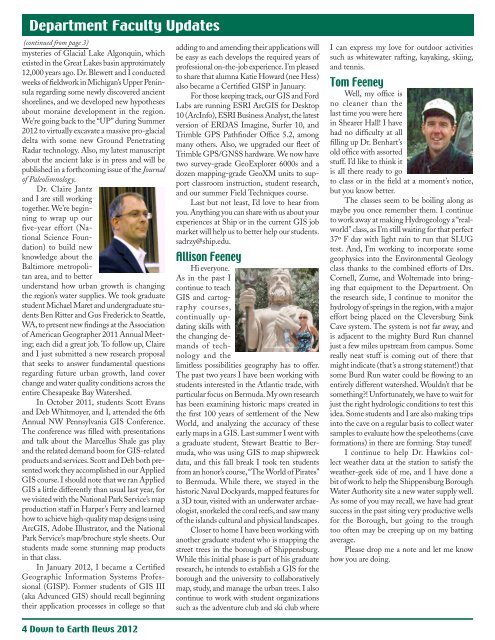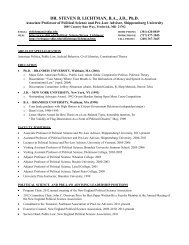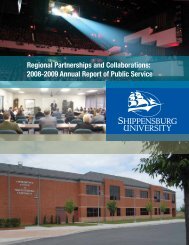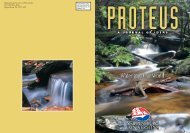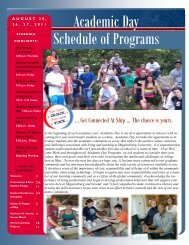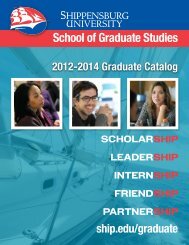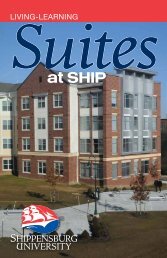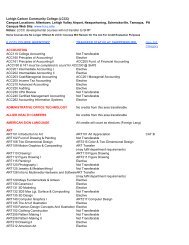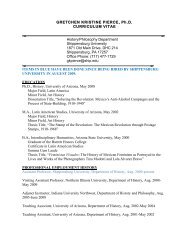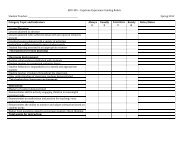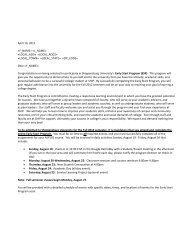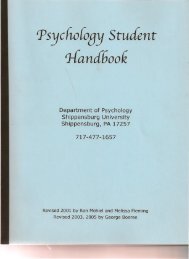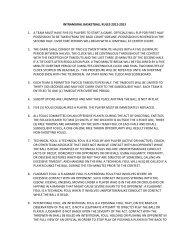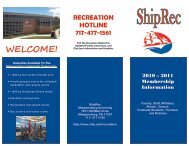pdf version - Shippensburg University
pdf version - Shippensburg University
pdf version - Shippensburg University
You also want an ePaper? Increase the reach of your titles
YUMPU automatically turns print PDFs into web optimized ePapers that Google loves.
Department Faculty Updates<br />
(continued from page 3)<br />
mysteries of Glacial Lake Algonquin, which<br />
existed in the Great Lakes basin approximately<br />
12,000 years ago. Dr. Blewett and I conducted<br />
weeks of fieldwork in Michigan’s Upper Peninsula<br />
regarding some newly discovered ancient<br />
shorelines, and we developed new hypotheses<br />
about moraine development in the region.<br />
We’re going back to the “UP” during Summer<br />
2012 to virtually excavate a massive pro-glacial<br />
delta with some new Ground Penetrating<br />
Radar technology. Also, my latest manuscript<br />
about the ancient lake is in press and will be<br />
published in a forthcoming issue of the Journal<br />
of Paleolimnology.<br />
Dr. Claire Jantz<br />
and I are still working<br />
together. We’re beginning<br />
to wrap up our<br />
five-year effort (National<br />
Science Foundation)<br />
to build new<br />
knowledge about the<br />
Baltimore metropolitan<br />
area, and to better<br />
understand how urban growth is changing<br />
the region’s water supplies. We took graduate<br />
student Michael Maret and undergraduate students<br />
Ben Ritter and Gus Frederick to Seattle,<br />
WA, to present new findings at the Association<br />
of American Geographer 2011 Annual Meeting;<br />
each did a great job. To follow up, Claire<br />
and I just submitted a new research proposal<br />
that seeks to answer fundamental questions<br />
regarding future urban growth, land cover<br />
change and water quality conditions across the<br />
entire Chesapeake Bay Watershed.<br />
In October 2011, students Scott Evans<br />
and Deb Whitmoyer, and I, attended the 6th<br />
Annual NW Pennsylvania GIS Conference.<br />
The conference was filled with presentations<br />
and talk about the Marcellus Shale gas play<br />
and the related demand boom for GIS-related<br />
products and services. Scott and Deb both presented<br />
work they accomplished in our Applied<br />
GIS course. I should note that we ran Applied<br />
GIS a little differently than usual last year, for<br />
we visited with the National Park Service’s map<br />
production staff in Harper’s Ferry and learned<br />
how to achieve high-quality map designs using<br />
ArcGIS, Adobe Illustrator, and the National<br />
Park Service’s map/brochure style sheets. Our<br />
students made some stunning map products<br />
in that class.<br />
In January 2012, I became a Certified<br />
Geographic Information Systems Professional<br />
(GISP). Former students of GIS III<br />
(aka Advanced GIS) should recall beginning<br />
their application processes in college so that<br />
adding to and amending their applications will<br />
be easy as each develops the required years of<br />
professional on-the-job experience. I’m pleased<br />
to share that alumna Katie Howard (nee Hess)<br />
also became a Certified GISP in January.<br />
For those keeping track, our GIS and Ford<br />
Labs are running ESRI ArcGIS for Desktop<br />
10 (ArcInfo), ESRI Business Analyst, the latest<br />
<strong>version</strong> of ERDAS Imagine, Surfer 10, and<br />
Trimble GPS Pathfinder Office 5.2, among<br />
many others. Also, we upgraded our fleet of<br />
Trimble GPS/GNSS hardware. We now have<br />
two survey-grade GeoExplorer 6000s and a<br />
dozen mapping-grade GeoXM units to support<br />
classroom instruction, student research,<br />
and our summer Field Techniques course.<br />
Last but not least, I’d love to hear from<br />
you. Anything you can share with us about your<br />
experiences at Ship or in the current GIS job<br />
market will help us to better help our students.<br />
sadrzy@ship.edu.<br />
Allison Feeney<br />
Hi everyone.<br />
As in the past I<br />
continue to teach<br />
GIS and cartography<br />
courses,<br />
continually updating<br />
skills with<br />
the changing demands<br />
of technology<br />
and the<br />
limitless possibilities geography has to offer.<br />
The past two years I have been working with<br />
students interested in the Atlantic trade, with<br />
particular focus on Bermuda. My own research<br />
has been examining historic maps created in<br />
the first 100 years of settlement of the New<br />
World, and analyzing the accuracy of these<br />
early maps in a GIS. Last summer I went with<br />
a graduate student, Stewart Beattie to Bermuda,<br />
who was using GIS to map shipwreck<br />
data, and this fall break I took ten students<br />
from an honor’s course, “The World of Pirates”<br />
to Bermuda. While there, we stayed in the<br />
historic Naval Dockyards, mapped features for<br />
a 3D tour, visited with an underwater archaeologist,<br />
snorkeled the coral reefs, and saw many<br />
of the islands cultural and physical landscapes.<br />
Closer to home I have been working with<br />
another graduate student who is mapping the<br />
street trees in the borough of <strong>Shippensburg</strong>.<br />
While this initial phase is part of his graduate<br />
research, he intends to establish a GIS for the<br />
borough and the university to collaboratively<br />
map, study, and manage the urban trees. I also<br />
continue to work with student organizations<br />
such as the adventure club and ski club where<br />
I can express my love for outdoor activities<br />
such as whitewater rafting, kayaking, skiing,<br />
and tennis.<br />
Tom Feeney<br />
Well, my office is<br />
no cleaner than the<br />
last time you were here<br />
in Shearer Hall! I have<br />
had no difficulty at all<br />
filling up Dr. Benhart’s<br />
old office with assorted<br />
stuff. I’d like to think it<br />
is all there ready to go<br />
to class or in the field at a moment’s notice,<br />
but you know better.<br />
The classes seem to be boiling along as<br />
maybe you once remember them. I continue<br />
to work away at making Hydrogeology a “realworld”<br />
class, as I’m still waiting for that perfect<br />
37º F day with light rain to run that SLUG<br />
test. And, I’m working to incorporate some<br />
geophysics into the Environmental Geology<br />
class thanks to the combined efforts of Drs.<br />
Cornell, Zume, and Woltemade into bringing<br />
that equipment to the Department. On<br />
the research side, I continue to monitor the<br />
hydrology of springs in the region, with a major<br />
effort being placed on the Cleversburg Sink<br />
Cave system. The system is not far away, and<br />
is adjacent to the mighty Burd Run channel<br />
just a few miles upstream from campus. Some<br />
really neat stuff is coming out of there that<br />
might indicate (that’s a strong statement!) that<br />
some Burd Run water could be flowing to an<br />
entirely different watershed. Wouldn’t that be<br />
something! Unfortunately, we have to wait for<br />
just the right hydrologic conditions to test this<br />
idea. Some students and I are also making trips<br />
into the cave on a regular basis to collect water<br />
samples to evaluate how the speleothems (cave<br />
formations) in there are forming. Stay tuned!<br />
I continue to help Dr. Hawkins collect<br />
weather data at the station to satisfy the<br />
weather-geek side of me, and I have done a<br />
bit of work to help the <strong>Shippensburg</strong> Borough<br />
Water Authority site a new water supply well.<br />
As some of you may recall, we have had great<br />
success in the past siting very productive wells<br />
for the Borough, but going to the trough<br />
too often may be creeping up on my batting<br />
average.<br />
Please drop me a note and let me know<br />
how you are doing.<br />
4 Down to Earth News 2012


